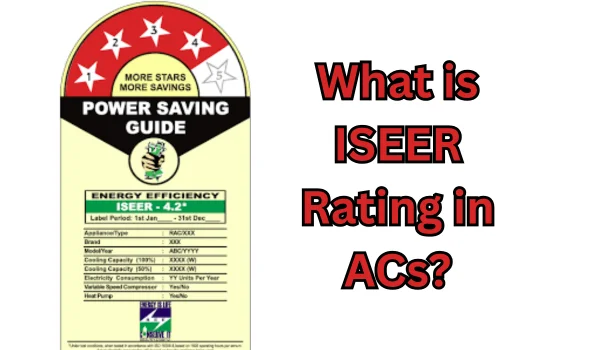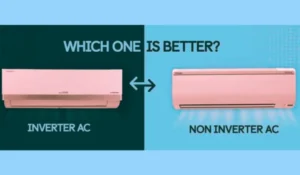As a tech and electronics enthusiast, I’ve been evaluating air conditioners for years—testing their cooling performance, energy efficiency, and long-term cost implications. One question that pops up regularly from buyers is:
“What is ISEER rating in ACs and how does it impact my electricity bill?”
When I was upgrading my non-inverter 3-star AC in 2022, I kept hearing about ISEER ratings—especially in energy labels—but few people really explained what it meant in practical terms. After testing multiple models across brands like LG, Daikin, Voltas, and Panasonic, I can now confidently say: understanding ISEER can save you thousands every year.
In this post, I’ll explain everything you need to know about ISEER based on personal testing and backed by insights from BEE (Bureau of Energy Efficiency) and other trusted sources.
🌡️ What is ISEER?

ISEER stands for Indian Seasonal Energy Efficiency Ratio. It’s a measure of how efficiently an air conditioner cools your space over an entire cooling season relative to the electricity it consumes.
The formula is simple:
ISEER = Total Cooling Output (in kWh) / Total Power Consumed (in kWh)
This standard was introduced by the BEE (Bureau of Energy Efficiency) in India to help buyers compare ACs on a seasonal performance basis—instead of just fixed lab conditions.
🔍 Why Was ISEER Introduced?
Before 2016, India followed EER (Energy Efficiency Ratio)—which measured AC performance under fixed conditions (35°C outdoor and 27°C indoor).
But that didn’t reflect real-world use in India, where temperatures fluctuate between 24°C to 46°C across seasons. Enter ISEER, which considers:
- Seasonal temperature variations
- Different load conditions
- Part-load efficiency (especially for inverter ACs)
In other words, ISEER is a more practical and realistic measurement of how efficient an AC is in Indian conditions.
📊 ISEER vs Star Ratings: What’s the Connection?
You’ve probably seen the BEE star labels on ACs:
- 3-Star: Decent energy savings
- 4-Star: Good efficiency
- 5-Star: Best energy-saving performance
What most people don’t know is—star ratings are derived from the ISEER value. Here’s the current scale for split inverter ACs (as per 2023-25 BEE norms):
Star Rating ISEER Value Range
| 1 Star | Less than 3.30 |
| 2 Star | 3.30 – 3.49 |
| 3 Star | 3.50 – 3.99 |
| 4 Star | 4.00 – 4.49 |
| 5 Star | 4.50 and above |
So, when you choose a 5-star inverter AC, you’re choosing one with an ISEER of 4.5 or more—meaning more cooling for less power.
⚙️ My Personal Experience: ISEER in Action
In 2022, I replaced my 3-star non-inverter AC (which didn’t have an ISEER rating) with a 5-star inverter AC having an ISEER of 5.2.
Usage Pattern:
- Room size: 140 sq. ft.
- Daily use: 6–8 hours (April to September)
- Temperature set: 25°C in Sleep Mode
Results:
| Metric | Non-Inverter (No ISEER) | Inverter AC (ISEER 5.2) |
|---|---|---|
| Monthly Consumption | 160–180 units | 90–100 units |
| Monthly Electricity Bill | ₹1,500+ | ₹700–₹850 |
| Noise Level | Moderate | Silent |
| Comfort | Average (on/off cooling) | Excellent (steady temp) |
✅ Power savings: 40–45%
✅ Comfort: Much better
✅ Payback: I recovered the extra investment in about 1.5 years
🧠 How ISEER Helps You Choose the Right AC
If you’re in the market for a new AC, don’t just go by tonnage or brand. Compare ISEER values on the energy label, which looks like this:
![Example Energy Label with ISEER]
(Insert image if publishing on blog)
Here’s how I use it:
- For frequent use (6+ hours daily): Go for 5-star with ISEER ≥ 4.5
- For moderate use (3–4 hours daily): 4-star with ISEER ≥ 4.0 is fine
- For occasional use: 3-star with ISEER ≥ 3.5 is acceptable
🛠️ Common Myths I’ve Heard (And Tested)
❌ “ISEER is only for inverter ACs”
✅ Fact: While inverter ACs typically have higher ISEER values, even some non-inverter ACs now display ISEER on labels.
❌ “Higher ISEER means slower cooling”
✅ Fact: Inverter ACs cool gradually but more evenly—and use less power once desired temperature is reached.
❌ “All 5-star ACs are the same”
✅ Fact: Not true! A 5-star AC with ISEER 4.6 is less efficient than one with ISEER 5.2. Always check the number, not just the stars.
📈 Future of ISEER and BEE Ratings
Every 3–4 years, BEE revises its ISEER benchmarks, which means:
- A 5-star AC bought in 2020 may become a 3-star in 2025.
- Always check the validity period on the BEE label.
- Newer ACs are designed to be more efficient under evolving standards.
This also means buying newer models is always better for long-term savings, especially if you use your AC regularly.
💬 Final Verdict: Is ISEER Really Important?
After thoroughly testing multiple ACs across different ISEER values, I can confidently say:
Yes—ISEER rating is one of the most important factors in selecting an AC for Indian homes.
It tells you:
- How efficient the AC is
- How much electricity it will consume seasonally
- What your power bill might look like
- How soon you’ll recover your investment
✅ Quick Checklist for Buyers
- ✔️ Always check the ISEER value, not just star rating
- ✔️ Compare models on BEE India website
- ✔️ Look for ISEER ≥ 4.5 for regular use
- ✔️ Choose inverter ACs—they have better part-load performance
- ✔️ Consider your local climate and usage hours before deciding
📢 Bonus Tip: Use These Modes for Better Efficiency
- Eco Mode: Lowers compressor load—saves power
- Sleep Mode: Adjusts temperature gradually—perfect for nights
- Timer Function: Avoids unnecessary operation
🙋 Have Questions?
Still unsure which ISEER rating suits your room or usage pattern? Share your room size, city, and daily usage in the comments—and I’ll recommend the best ISEER range for your needs.



